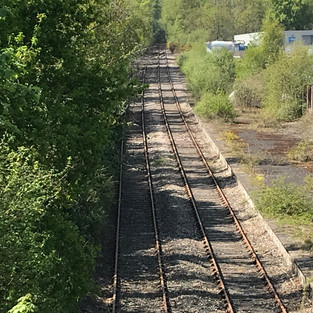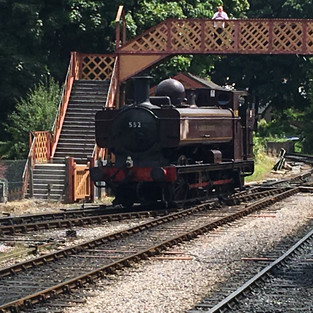The first cut
- Ed Goodridge
- Jun 18, 2020
- 4 min read
Updated: Jun 19, 2020
In 1963 Dr Richard Beeching published his report “The Reshaping of British Railways” recommending the closure of many of the West Country’s rural branch lines but this was not the first time officials had tried to bring order to the country’s Victorian railway infrastructure ravaged by war and underinvestment. In December 1954, the British Transport Commission (BTC) had published a document called “The Modernisation and Re-equipment of British Railways”. This set out the broad principles that would define railway policy for the next thirty years or so. The study aimed “to produce a thoroughly modern system, able fully to meet both current traffic requirements and those of the foreseeable future”. The plan was to be completed in 15 years and sought to “exploit the great natural advantages of railways as bulk transporters of passengers and goods”.
Teign Valley branch line stations at Trusham, Ashton and Christow.
Line closed to passengers between Heathfield and Exeter in 1958.
Nine years after the end of the Second World War, the BTC report claimed that the railways had not been given a share of post-war capital investment comparable with that allocated to railways in many other countries. “ It is not so much a question of whether the nation can afford to undertake the new investment in its railway system here proposed, as whether it can afford not to do so and thereby continue to carry the economic burden of a public transport system that lags far behind the standard of efficiency technically possible”.
The British Transport Commission planned to spend 1,200 million pounds improving train speeds by fitting modern signalling, replacing steam engines with diesel and electric ones, modernising rollingstock and stations, introducing diesel multiple unit trains and remodelling the freight operation.
Teignbridge Crossing, Teigngrace Station and Heathfield Station on the Newton Abbot to Moretonhampstead branch line. Closed to passengers in 1959.
Looking ahead to 1970, the report predicted that the character of passenger services would change with additional fast long-distance trains and more suburban services required. It stated in no uncertain terms that British Railways needed to escape from the “un- sound and indeed unjustifiable position under which they are obliged to retain unremunerative stopping-train services that have to be subsidised by the fare receipts from express and other services”. Ever since the 1920s rural buses had gained in popularity and in the 1950s private car sales were increasing. Consequently the BTC looked to cut costs by reducing the number of stopping and branch-line services which were little used by the public and which, “on any dispassionate review of the situation, should be largely handed over to road transport”. The main problem with these predominantly country services was the heavy financial losses incurred operating steam trains with non-corridor carriages. The aim was to try and make the services pay with diesel multiple units in the hope that these would attract some traffic or close them and uses buses instead. Stations also came under fire. The plan aimed to reduce costs by closing little used wayside stations that could not be converted into unstaffed halts. Many rural goods depots would also have to close with their traffic concentrated in a smaller number of large modern depots.
Brixham Station bridges and MP 227 sign on bridge. Closed 1963
The closures started just over a year after publication. The first passenger service to go in Devon was that on the branch line from Yelverton to Princetown in March 1956, followed by the Teign Valley line in June 1958. Later in that same year passenger trains stopped running between Totnes and Ashburton and services to Moretonhampstead were withdrawn in 1959. Good trains to Yealmpton ceased in 1960 and two years later the former GWR line between Plymouth, Tavistock South and Launceston closed. 1963 saw two further closures namely the branches to Brixham and Kingsbridge although these happened just after the publication of the Beeching report.
Yelverton to Princetown branch line closed 1956 and now a cycle path
The 1954 plan did not only radically lay out a change of attitude towards rural train services. It heralded the end of steam. By 1969, it stated that about 2,500 main-line diesel locomotives should be in use. For example, on the Western Region the British Transport Commission planned to eliminate all steam working beyond Newton Abbot and to employ diesel units on a large proportion of the passenger and freight trains. On the Southern Region diesel was to replace steam between Waterloo and Exeter.
Ex GWR tank 5786 (L92), BR bubblecar W55000 and GWR tank engine 1450 all at Buckfastleigh on the now preserved Totnes to Ashburton branch closed by BR in 1958
The problem with this 1955 report into modernisation and the 1963 Beeching report is that both looked at the “foreseeable” future without considering what might happen in thirty, forty, fifty years’ time. Population growth, climate change and the massive shift to imported goods mean that we are now having to rebuild railways and expand infrastructure. Many of the rural branches would still be uneconomic and some of the rural areas affected ARE probably best served by road but commuter lines into Plymouth for example closed by Beeching are being considered for reopening and there are campaigners calling for the redoubling of the Waterloo to Exeter line and the reopening of stations in market towns like Cullompton.





























Thanks Ed. Good stuff. Most people think all closed lines were Beeching's doing but the railways have been closing lines and stations since railways began.